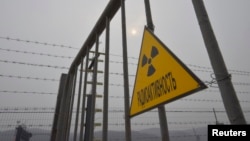MOSCOW -- The radiation that drifted over Europe in late September likely originated from a Russian nuclear complex that is one of the most polluted areas in the country, experts say, but does not represent any danger to health if publicly available figures are accurate.
Weeks after European monitoring agencies reported a spike in radiation levels over parts of the continent, Russia's meteorological service on November 21 said two monitoring stations near the complex had recorded "extremely high" concentrations of the radioactive isotope ruthenium-106.
This marked the first confirmation from Russian authorities about the mysterious cloud, which European agencies concluded came from either Russia or Kazakhstan.
The isotope is relatively harmless, but the mystery surrounding the cloud, Russian authorities' slow acknowledgment of the incident, and the history of the site where the radiation emanated from has fueled suspicions.
It has also evoked memories of the 1986 Chernobyl nuclear disaster, where Soviet authorities took days to admit a catastrophic failure at the plant that spewed radiation across Northern Europe.
Local activists said the information vacuum around the incident recalled the Soviet response to the Chernobyl disaster, and was deepening distrust of official statements.
"It's sad that we learned about this from Western media," Albert Garapov, the chairman of the Tatarstan Antinuclear Society, told RFE/RL's Tatar-Bashkir Service. "People are anxious for information to know whether it's dangerous or not, expecting explanations if it is dangerous or not."
READ MORE: Locals Left In Dark About Russian Radiation Spike
Last month, the state-controlled nuclear corporation Rosatom rejected the European conclusions that Russia was the source of the findings, saying that radiation levels around all its atomic stations were normal.
However, Rosgidromet, the Russian meteorological agency, said it had measured nearly 1,000 times the normal levels of Ru-106 pollution at its Argayash weather station in the Chelyabinsk region in late September and early October. Another nearby station called Novogorny recorded 440 times the normal levels.
The statement does not clarify the exact origin of the contamination, however. Argayash is just 30 kilometers from the Mayak nuclear facility, near the secret town of Ozyorsk, which is closed off to foreigners and is known as one the most polluted areas in Russia.
Boris Zhuykov, a scientist at the Russian Academy of Sciences, told RFE/RL's Russian Service that the most likely source was Mayak. "The fact that it is mainly ruthenium-106, and that there are no other [isotopes such as Ru-103], suggests that first of all, it came from the boiling of aqueous solutions," he said. "There are lots of those types of solutions [at Mayak]. It is possible they evaporated them to transport them in solid state."
Experts ruled out a Chernobyl-style accident that would have released other radioactive pollution, and not just ruthenium-106.
Mayak denied responsibility, saying it had not produced ruthenium-106 in 2017 and that its emissions into the atmosphere had been normal throughout.
Nadezhda Kutepova, an ecologist from Ozyorsk who fled Russia to France in 2015 after facing allegations of industrial espionage, said that she believed that the ruthenium came from Mayak's electric furnace during nuclear waste processing on the night of September 25-26.
During the Soviet era, the top-secret Mayak facility produced plutonium for nuclear weapons and also reprocessed fuel used in the country's atomic energy plants. In September 1957, a cooling system failed on a unit storing radioactive waste, resulting in an explosion that sent a plume of radioactive material over hundreds of kilometers. Thousands of villagers were reportedly evacuated.
The accident was kept secret, though environmental activists and local residents documented health and environmental problems for years afterward.
PHOTO GALLERY: 'Left To Die As Guinea Pigs': Tatar Village Struggles On, 60 Years After Nuclear Catastrophe
Kutepova said nuclear waste had been dumped into a nearby river from 1949 to 1952, which destroyed the ecology of the river and the surrounding environment.
Mayak has "huge experience in covering up information and misinforming about radiation accidents," Kutepova wrote.
Rashid Alimov, head of Greenpeace Russia's energy program, said other possible causes for the contamination included the crash of a satellite and a medical equipment manufacturer making use of ruthenium.
Experts said the radiation levels do not appear to pose any health threat.
"All these panicky numbers that activity has surpassed background levels hundreds of times doesn't tell us anything," Zhuykov said. "We need to look at whether the maximum permissible dose has been reached or surpassed. According to the data that's been published, we are 24 times lower than the permissible average activity."
Vitaly Fedchenko, an expert on nuclear energy at the Stockholm International Peace Research Institute, noted that "From the public statement by radiation protection authorities in the three counties -- Russia, France, and Germany -- the concentration of ruthemium-106 involved in this particular case is way too low to be any kind of health and safety concern for the public."
Interview: Experts See No Health Threat In Russian Radiation Leak, Suspect Storage Accident
Alimov was less positive about potential health risks. He said ruthenium-106 does not occur naturally and that its presence indicates some sort of accident has taken place. "In radiology, there is threshold theory that holds that any additional radiation increases the risk of contracting cancer," he told RFE/RL's Russian Service.















